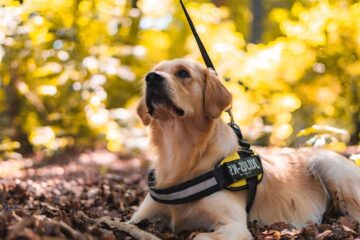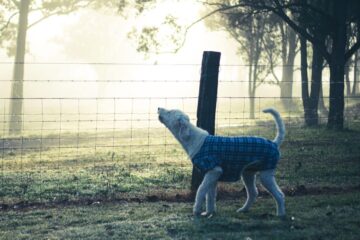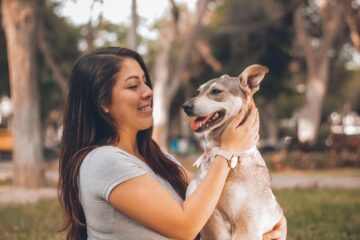Key Takeaways
- Dogs often sleep in the „dead dog pose” which is on their back.
- Reasons for this include comfort, safety sensation and stiff joints as well as improved body temperature regulation, reduced stress and overall health promotion.
- Not all dogs sleep on their backs; size of breed can determine how they lay down while age also plays a role.
- Owners should pay attention to signs that indicate if a pet is comfortable when sleeping in this position such as relaxed body language or deep breathing patterns.
- To improve your pet’s quality of restful sleep there are certain steps you can take like creating a quiet environment with consistent bedtime/wake-up times and providing them with exercise during the day.
Why does my dog sleep on his back and what does it mean? Well, this position is often called “the dead dog pose.” It turns out, there is a scientific reason why dogs like to curl up in this position! Join our discussion!
Why Does My Dog Sleep on His Back? Top Reasons
Here are a few top reasons why Bernie might be constantly snoozing on his back. Take a look:
Pure Comfort
Your dog might be sleeping on its back because of pure comfort. According to a recent study, this position allows dogs to regulate their body temperature more efficiently. Dogs have a higher number of heat-sensitive receptors on their belly, so lying on their back exposes these receptors to the cool air and helps them stay comfortable. In addition, this position allows dogs to relax their muscles and breathe more easily.
Stiff Joints
Some dogs also sleep on their back to avoid putting pressure on their joints. If your dog is suffering from arthritis or hip dysplasia, sleeping on its back can help to minimize pain and keep joints in alignment. If your dog has stiff joints, avoid letting it jump off furniture or stairs. Instead, provide ramps and assistance to help it get up and down safely.
Safety Sensation
Dogs curl up on their backs for a variety of reasons, usually to feel safe and secure, i.e. the “dead dog pose” is a defensive position. When dogs feel unsafe or threatened, they will often roll onto their backs to expose their belly and show that they are not a threat. This is a submissive position that dogs will take when they feel scared or intimidated.
However, not all dogs who sleep on their backs are doing so because they feel threatened. Some dogs just find this position to be comfortable!
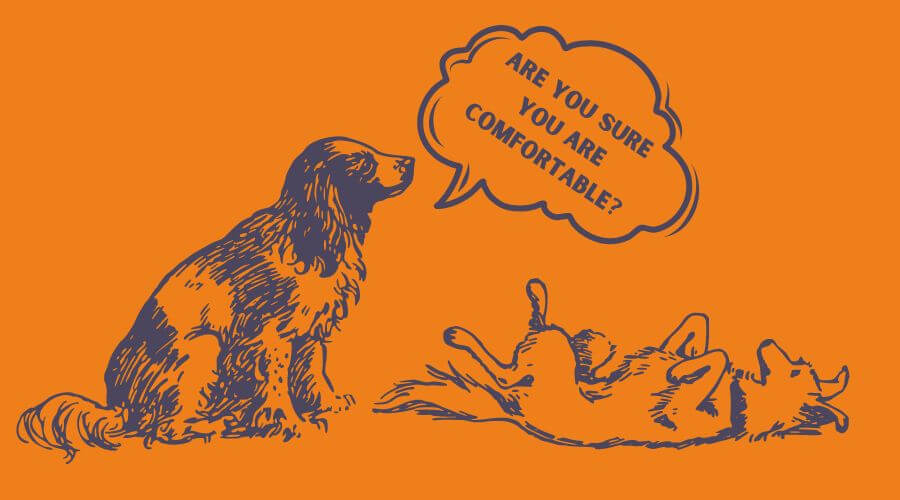
Surroundings Control
Curling up in this position makes it difficult for predators to attack from the front. That means that if a dog is sleeping on its back, it can rest assured that it won’t be attacked from the front. This position also allows a dog to keep an eye on its surroundings.
Sleeping on your back with your legs in the air may not seem like the best way to keep watch, but it actually allows a dog to see in all directions! It also allows dogs to access vital organs quickly if they need to protect themselves.
Showing Submission or Sensitivity
Sleeping on their backs might also be a way for dogs to show submission or vulnerability. i.e. they are not looking for a fight. This is especially true when they are in the presence of other dogs, as it helps them to avoid confrontation. Dogs can also show sensitivity by sleeping on their backs, as this is seen as a sign of trust and willingness to be vulnerable.
A Habit From Your Dog’s Ancestors
Some experts believe that this sleeping position is just something that has been passed down through generations of dogs. Napping on your back might just be a comfortable position that has been passed down through the generations!
Why does my dog sleep on his back? You should know by now!
Our Reader’s Story
My dog, Buster, loves to sleep on his back with all four legs in the air! I was always curious why he does this, so I did some research and found out that it’s actually a sign of trust. When a dog sleeps on his back, he’s exposing his most vulnerable parts, like his belly and throat. This means he feels safe and secure enough to let his guard down.
It’s also a way for him to cool down. Dogs don’t sweat like humans do, so they rely on panting and releasing heat through their paws and belly. Sleeping on his back allows more air to circulate around his body and keep him cool.
So the next time Buster is snoozing on his back, I’ll know he’s feeling content and comfortable in his home.
Benefits and Drawbacks of a Dog Sleeping on Their Back
Dogs love to sleep in a variety of comfy ways, from curling up into furry balls to sprawling on their stomachs. But one position that seems peculiarly adorable – and even slightly silly! – is when they stretch out on their backs with all four legs kicked up in the air while snoozing. As it turns out though, there are some serious health benefits associated with sleeping this way: better joint protection & improved digestion just to name a few!
Pros
For one thing, it allows your dog to cool off more easily. Dogs regulate their body temperature by releasing heat through their paws, and sleeping on their back gives them more surface area to do so. Additionally, sleeping on your back gives your dog’s internal organs a chance to rest and allows blood to circulate more easily. As a result, sleeping on your back can help to reduce stress and promote overall health.
Cons
Of course, there are also a few drawbacks to this position. For example, dogs who sleep on their back are more vulnerable to predators and may have difficulty getting up if they’re not used to it. Nevertheless, the benefits of sleeping on your back seem to outweigh the drawbacks for most dogs. So if you see your dog kicking up his legs in the air during nap time, don’t be too alarmed, as he’s just taking advantage of the benefits of this unique sleeping position!
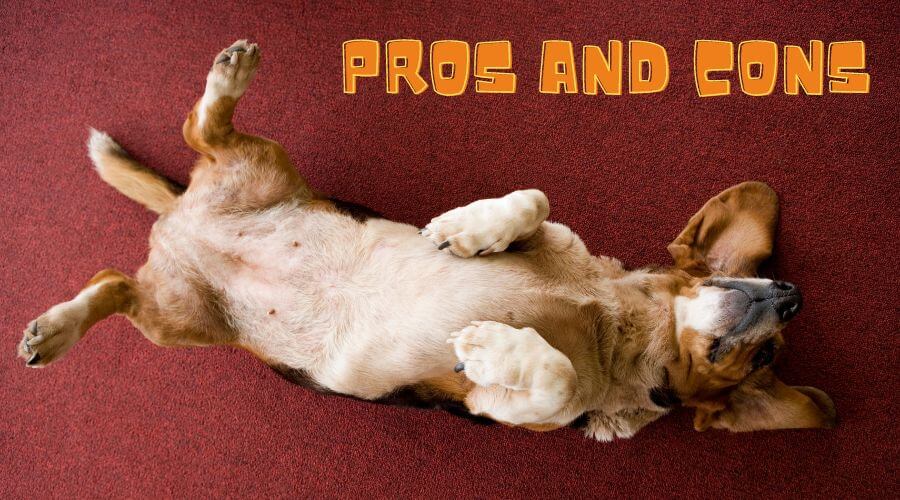
Do All Dogs Sleep on Their Backs?
There’s more to a dog snoozing than meets the eye! Although it might look funny, dogs actually sleep in many different ways. Small pups often curl up and larger breeds tend to sprawl out – but that’s not all; size isn’t the only factor influencing how your four-legged friend slumbers. Depending on their breed, age and health status, each pooch has its own unique approach when it comes time for some shut-eye.
Older dogs often prefer to sleep on their sides, while young puppies often sleep on their stomachs. And finally, sick or injured dogs will often seek out a comfortable position that doesn’t put any pressure on their sore muscles or joints. So next time you see your dog snoozing away, take a moment to notice what position they’re in. You might just learn something about them!
How Can You Tell If Your Dog Is Comfortable Sleeping on Their Back?
Dogs are usually seen snoozing on their side and stomach, but have you ever caught your canine companion enjoying some shuteye in the less common position of lying flat on their back? While this type of sleep is not too prevalent among pooches, there are certain special circumstances when a pup might be found dozing off with all fours up! Luckily enough, it’s easy to identify whether or not they’re really feeling at ease.
- First, check to see if your dog is panting excessively or appearing anxious. If they are, it’s likely that they’re not comfortable and may be trying to cool down.
- Secondly, take a look at your dog’s body language. If they’re relaxed and their legs are splayed out, it’s a good sign that they’re comfortable.
- Finally, listen to your dog’s breathing. If it’s deep and steady, they’re likely in a deep sleep and feeling content. If you notice any of these signs, it’s safe to say that your dog is comfortable sleeping on their back.
Check also: Why does my dog twitch in his sleep?
Tips for Improving Your Dog’s Sleep
Sleeping is an important part of a dog’s overall health, but some dogs struggle to get enough shut-eye. If your dog is having trouble sleeping, there are a few things you can do to help them get the rest they need.
- First, make sure that their sleeping area is quiet, dark, and comfortable. Dogs are highly sensitive to noise, so any kind of unwanted sound can disrupt their sleep. Likewise, creating a calm environment will help them to relax and fall asleep more easily.
- Secondly, establish a regular sleep routine and stick to it as much as possible. Just like humans, dogs benefit from having a consistent bedtime and wake-up time.
- Lastly, provide them with plenty of exercise during the day. A tired dog is a sleepy dog, so a vigorous play session or a long walk will help them to wind down at night.
By following these tips, you can encourage your dog to get the restful sleep they need.
When Should Owners Interrupt Their Dogs’ Sleep?
Dogs usually sleep 12-14 hours a day, but that doesn’t mean they’re always down for a nap. In fact, there are plenty of situations when a dog owner should wake his pooch from a sound sleep. If there’s a loud noise outside or someone at the door, for example, it’s best to rouse the dog, so he can investigate and protect his home.
Other times when it’s appropriate to wake a sleeping dog include during a fire drill, if there’s smoke or an unusual smell in the air, or if the house is flooding. Of course, it’s also important to let your dog enjoy some uninterrupted rest, so use your best judgment before you start shaking him awake every chance you get.
So, why does my dog sleep on his back? There you have it! It turns out there’s actually a scientific explanation for this unique behavior! Dogs are incredibly intelligent and complex animals, so it’s no surprise that we’re still learning new things about them every day. Do you have an experience with a four-legged friend who prefers sleeping in the 'resting position’? Share your stories with us – let’s learn more together!
Frequently Asked Questions
Are Dogs Happy When They Sleep on Their Back?
Dogs are content and secure when they sleep on their backs, a sure sign of relaxation in the safety of their home.
Why Your Dog Shouldn’t Sleep With You?
Having a healthy relationship with your pup means setting the tone from day one, so it’s important to create boundaries early on. Letting them sleep in bed may seem cozy and sweet; however, this can inadvertently cause difficulty down the road by blurring traditional leadership roles between owner and pet – potentially leading to behavioral problems.
Does a Dog Trust You if They Sleep Next to You?
A dog’s presence in your bed is not just a sign of convenience – it means they trust you, feel safe and secure around you, creating an intimate bond that lasts all night long.
Do Dogs Like When You Pet Them While They Sleep?
Yes, most dogs enjoy being petted while they sleep. This can help them feel safe and secure, as well as help them relax.
What Does It Mean When a Dog Falls Asleep on You?
When a pup cuddles up against you and dozes off, it’s more than just an adorable moment – they are conveying their deepest feelings of security, trust and love.
Sarah Jameson is a journalist, reporter and a pet nutritionist. She is married to Peter, and they have two beautiful children, Zoey and Quinn. In her spare time, Sarah enjoys cooking for her family and playing snooker. She also loves spending time with her Scottish Terrier, Bobby.


